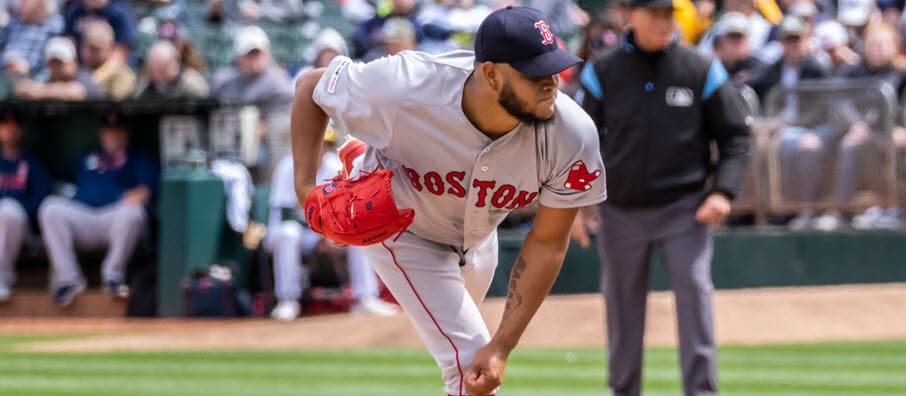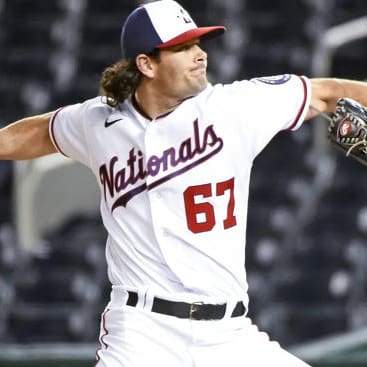This article is part of our Mound Musings series.
Last week we explored reasons to believe some pitchers who experienced disappointing seasons in 2019 might be candidates to bounce back in 2020 – of course assuming there is a 2020. The guys who do turn things around in a positive way are very likely to offer value on draft day because most recent numbers are frequently over-emphasized when fantasy owners do their player analysis. This week we'll look at the flip side of that coin. Some pitchers enjoyed very strong, even surprisingly strong, seasons last year. Can we expect the same (or in some cases even better) this season? If the draft day bidding reflects last year's numbers, and this year's results don't match up, the result is negative value. Obviously, that is something we all want to avoid. Let's take a look at that coin and see if there are some pitchers we might want to avoid.
The Best Play Might be to Stay Away: I'm always on the lookout for pitchers who could provide positive value. Find enough of them, and it's likely you will compete for a championship in your league. Conversely, there will be players who had very impressive seasons last year, leading to frequently inflated prices on draft day even though a repeat of 2019 seems unlikely. Pretty simple really, it amounts to Value 101, and that's the way to win fantasy leagues.
Our primary premise is, fantasy owners often weight their draft/auction values on what the player did the previous season. Obviously that
Last week we explored reasons to believe some pitchers who experienced disappointing seasons in 2019 might be candidates to bounce back in 2020 – of course assuming there is a 2020. The guys who do turn things around in a positive way are very likely to offer value on draft day because most recent numbers are frequently over-emphasized when fantasy owners do their player analysis. This week we'll look at the flip side of that coin. Some pitchers enjoyed very strong, even surprisingly strong, seasons last year. Can we expect the same (or in some cases even better) this season? If the draft day bidding reflects last year's numbers, and this year's results don't match up, the result is negative value. Obviously, that is something we all want to avoid. Let's take a look at that coin and see if there are some pitchers we might want to avoid.
The Best Play Might be to Stay Away: I'm always on the lookout for pitchers who could provide positive value. Find enough of them, and it's likely you will compete for a championship in your league. Conversely, there will be players who had very impressive seasons last year, leading to frequently inflated prices on draft day even though a repeat of 2019 seems unlikely. Pretty simple really, it amounts to Value 101, and that's the way to win fantasy leagues.
Our primary premise is, fantasy owners often weight their draft/auction values on what the player did the previous season. Obviously that should be a factor in your rankings, but it should not be too heavily weighted. There are usually several factors to consider. It could be something as random as good luck; something as obvious as a new face about whom the league hasn't had time to develop a book; something as subtle as a deceptive motion that initially befuddles hitters; or even command inconsistency that seemed to fall on the positive side of the ledger more often than expected. In many cases it's all of the above to some extent. Yes, the pitcher could simply be developing and taking his game to the next level (those guys are often good investments), but we need to sort them out.
I mentioned the Golden Rule for fantasy baseball last week, but I want to throw it out there again. What a pitcher might do in the upcoming year is far more important than what he did last year. Always keep in mind, this sword can cut both ways. A career year last year may not always result in the same this season, and a poor year last year might be explainable, leading to both targetable pitchers and pitchers to avoid when building your pitching staff.
Some Notable Rotation Ramblings Regarding Pitchers to Avoid:
- Eduardo Rodriguez (Red Sox) – He was arguably the ace of Boston's staff in 2019 with a 19-6 record and a respectable 3.81 ERA. However, his 1.33 WHIP should bring out some red flags. He was healthy last year after dealing with some injuries in previous seasons, but his repertoire is still too inconsistent, and the high number of baserunners likely will come back to haunt him moving forward.
- Max Fried (Braves) – Like Rodriguez above, Fried compiled a lot of wins (17), and his overall peripherals weren't too bad, even though his 4.02 ERA wasn't that impressive. My concerns with him center on repertoire. He has three decent pitches, but he quit using an inconsistent changeup. I'm afraid once the league gets a better feel for his stuff, he'll become more vulnerable to righty swingers.
- Lance Lynn (Rangers) – I'll say upfront, Lynn may not deserve to be on this list, especially this season. In the past, he has displayed a tendency to wear down in the later stages of the season. Last year he tossed 208 innings, and that didn't happen, presumably because of better conditioning. This season will be shorter, so it should be less of a concern, plus perhaps he is staying in better shape.
- Dakota Hudson (Cardinals) – Yet another pretty big winner (16-7) probably without the stuff to repeat his 2019 success. Hudson has good but not great stuff, and his command of his repertoire is spotty (an unsightly 1.41 WHIP with 4.4 walks per nine innings). Injuries to the St. Louis staff kept him in the rotation most of the year, but he would be better served working as a swingman/spot starter.
- Mike Fiers (A's) – The 34-year-old Fiers is something of a soft-tosser who relies on savvy more than stuff to survive. When everything is perfectly in sync, it works alright, but he gives up a lot of fairly hard contact, which was luckily hit right at someone more often than you would expect, making his extremely low .256 BABIP unlikely to repeat. A low strikeout rate doesn't help his cause.
- John Means (Orioles) – I was asked by several readers last season if Means was worth pursuing. My answer remains pretty much the same even though his numbers were respectable in 2019. Means is a younger version of Fiers, but probably not quite so savvy. Every team has a guy leading their rotation, and in Baltimore he is it. But, in most cities, he is probably a No. four or five.
- Brett Anderson (Brewers) – When fully healthy, Anderson can be reasonably effective. Last year he collected 13 wins, with decent peripherals, while hurling 176 innings for Oakland. The problem is, that's only the second time he has compiled 175-plus innings since 2009. Now in a more hitter friendly environment in Milwaukee, he's hard to count on as anything more than a streaming option.
- Anibal Sanchez (Nationals) – He's also endured a long list of injuries over his career. The problem with Sanchez is his tendency to try and pitch through the nagging aches and pains. In most cases, it hasn't worked, often inflating his peripherals and adversely affecting the numbers for his fantasy team. If you own him, just be ready to jump ship if his performance takes an unexpected dip.
Young Pitchers Could Have Various Roles: From a fantasy perspective, perhaps the biggest question still looming is the impact of high upside young pitchers if and when baseball returns. Ownership and the union continue to squabble over money, and the investment in each organization's top prospects makes this question very important.
First up, it still looks more and more like the minor league season won't happen in 2020. No minor league season equates to a hole in the developmental plan for the best young arms in the systems. These guys need to face live hitters in a competitive environment. The decision therefore comes down to having them pitch at the MLB level, or effectively delaying the pitcher's developmental progress. Pitchers ready (or very close) to compete at the highest level will probably slide into a role with the big club, but it's less clear what will happen with pitchers who aren't ready for the show.
Some teams, the A's for example, have hinted that their top young arms will be included in their 2020 pitching plans. Jesus Luzardo and A.J. Puk are both potential fantasy contributors, and both reportedly will have no restrictions on workload. However, I think they fall into different categories: ready and very close. Luzardo looks ready, and I would pursue him as a possible key member of my fantasy pitching staff, but Puk still needs to show more consistent command.
Reviewing some of the top prospects on my watch list, several fall into that gray area of "very close" to being ready. My top two, MacKenzie Gore and Nate Pearson, probably could use at least a half season competing at the Triple-A level. Forrest Whitley, Matt Manning and Casey Mize may be a little further away, while Michael Kopech and Spencer Howard might be a little closer.
My guess, and it's purely speculation at this point, the very best prospects will be with the big clubs as part of the anticipated expanded rosters, but their roles could often be determined by their position on the developmental timeline. Those deemed ready could take regular turns in the rotation, while those not quite there could be used in more protected roles like short spot starts or even out of the bullpen, which would theoretically reduce their fantasy impact this season.
The Baseball Return Watch: There's not much new to report regarding the possible resumption (delayed beginning) of the 2020 season. There will probably be expanded rosters, and it looks like there will be a universal designated hitter in every lineup, but the how and when things could actually start rolling is still very much up in the air.
Endgame Odyssey:
As with most player news during the current pandemic, updates on most relievers have been somewhat limited. News regarding potential closer candidates returning from extended time off like Jordan Hicks, Corey Knebel, Ryne Stanek, and the suspended Emmanuel Clase have been generally positive as they benefit from the additional rehab time. Even relievers like David Robertson and Reyes Moronta, who are not expected to return until later in the year may be able to contribute. The good news is relievers typically don't require as much prep time to be game-ready. However, there is a flip side to this coin, too. A shorter season could make managers less likely to change roles.










